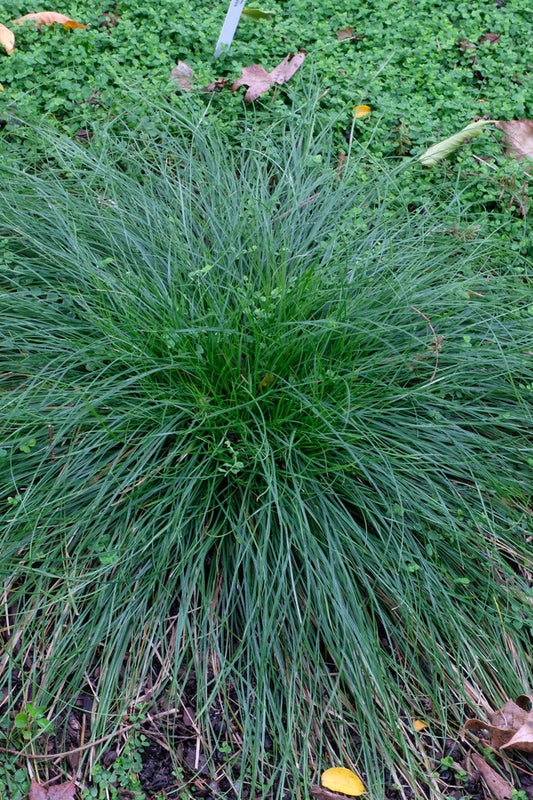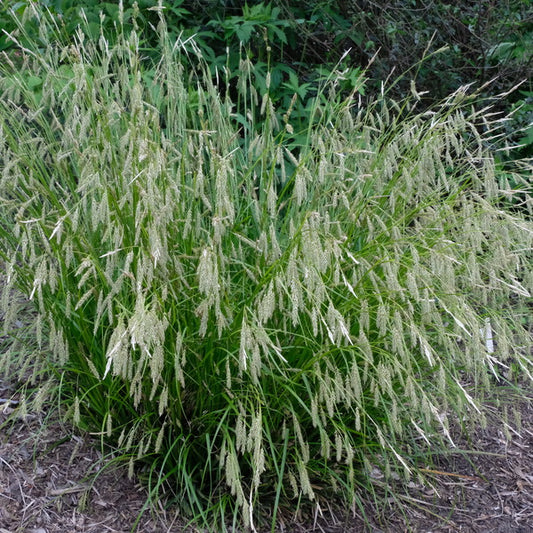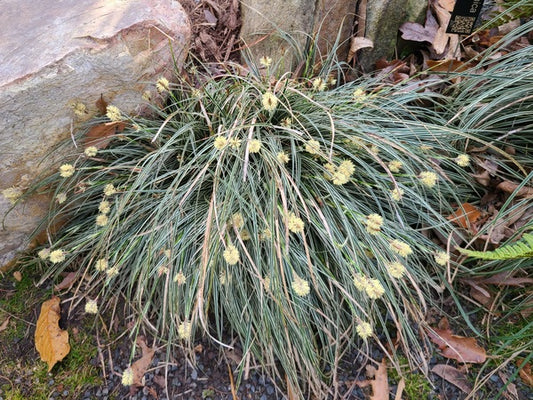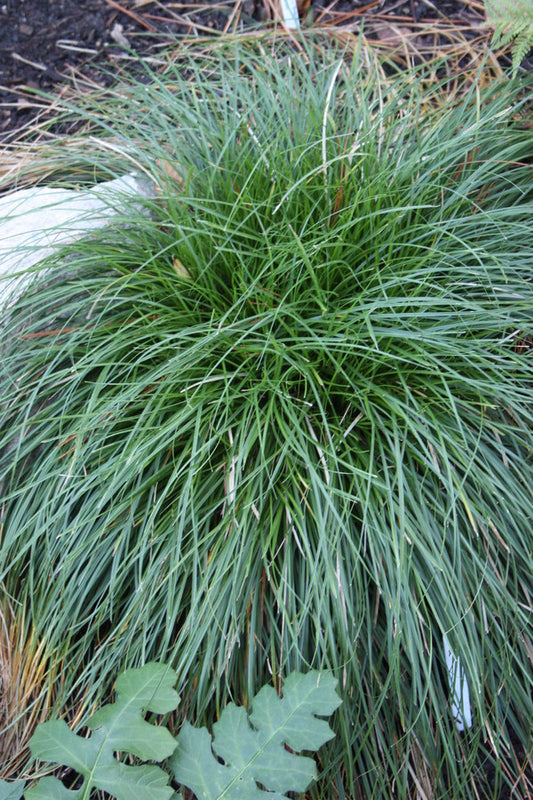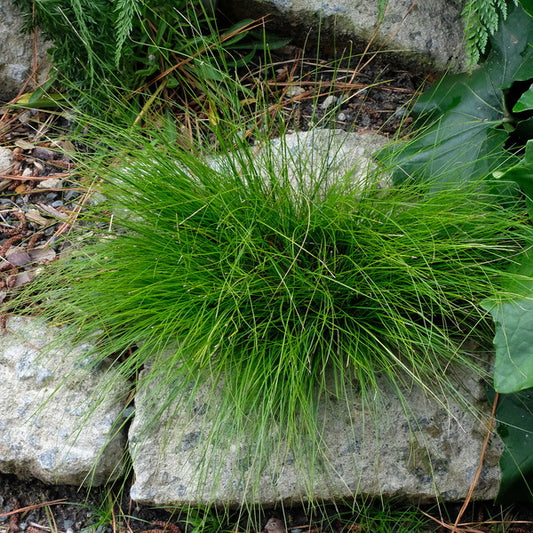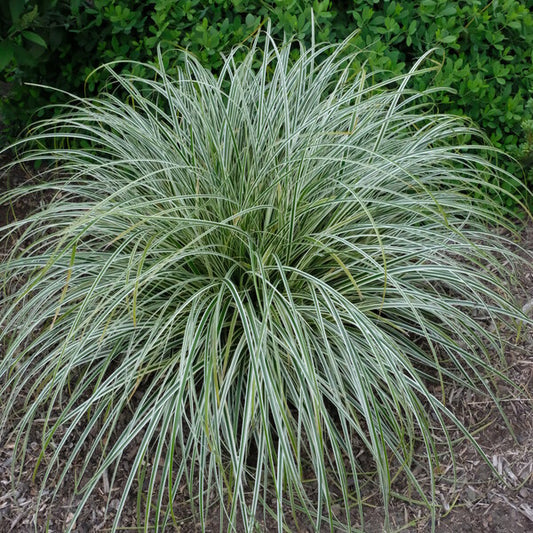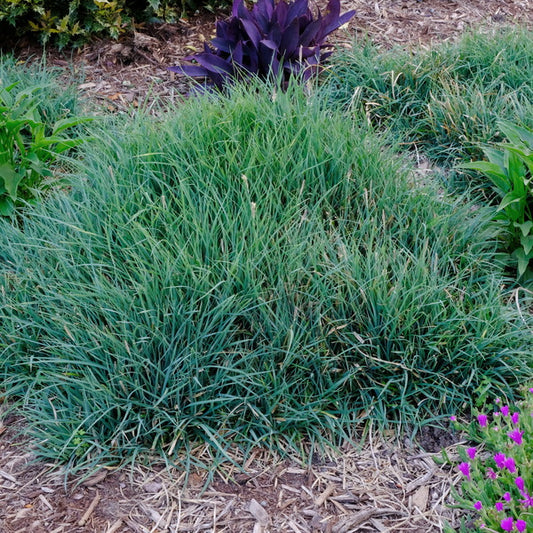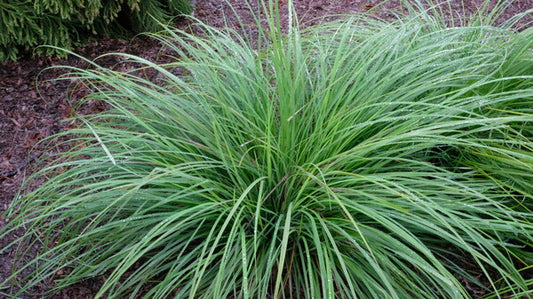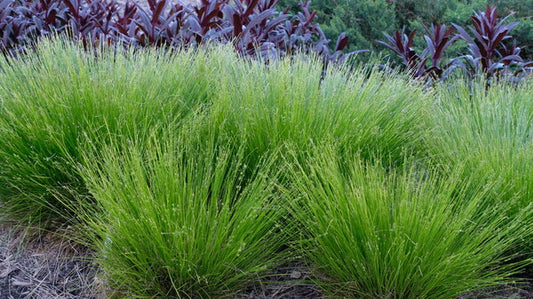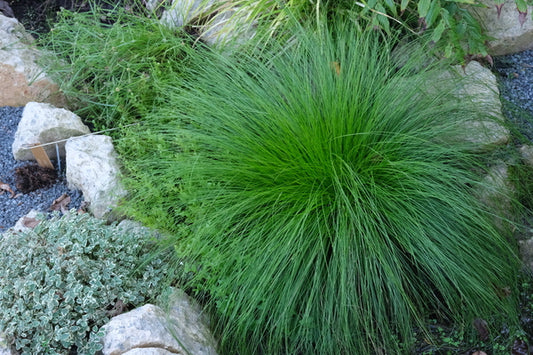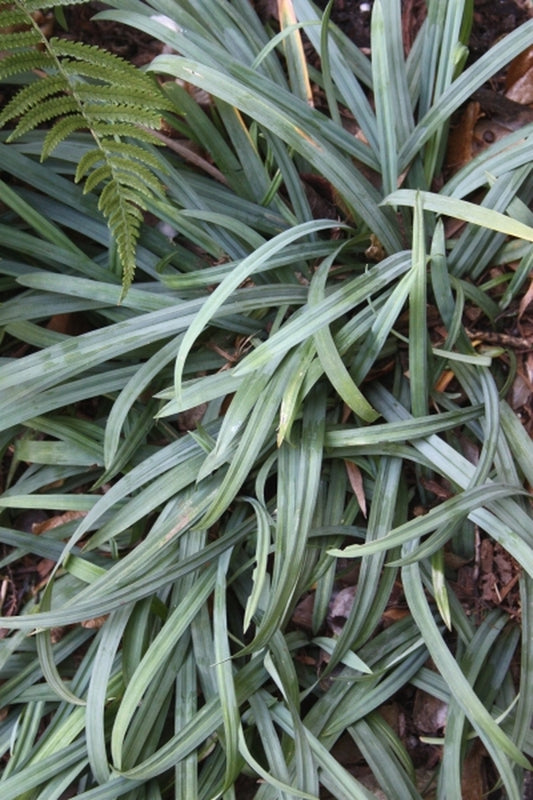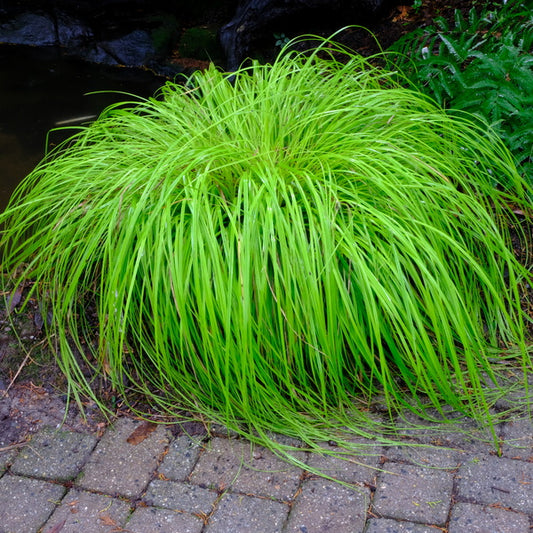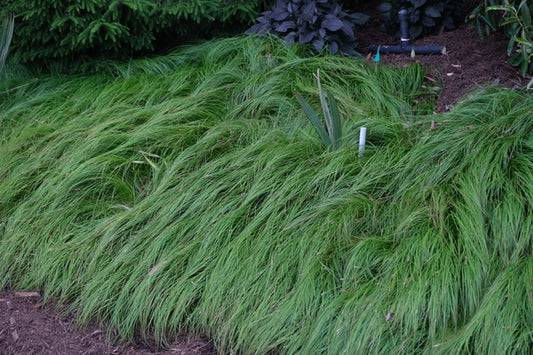Sedges are a grass-like plant in the genus Carex. Sedge grass is a mostly evergreen, shade plant that blends texturally with most plants. Many carex are even suited to perform such mundane garden functions as lining pathways in a woodland garden. Great companion plants to hostas, most carex perform their best when grown in a moist location, although they are somewhat tolerant of neglect and resistant to deer...give a carex a try!
-
Carex appalachica
Item #: 5793
Zones: 4a to 7b, at least
Dormancy: Winter
Height: 6" tall
Culture: Light Shade to Shade
Origin: United States
Pot Size: 3.5" pot (24 fl. oz/0.7 L)
Regular price $21.00Regular priceUnit price per -
Carex bromoides
Item #: 12439
Zones: 4a to 8b, at least
Dormancy: Winter
Height: 6" tall
Culture: Sun to Shade
Origin: Canada, United States
Pot Size: 3.5" pot (24 fl. oz/0.7 L)
Regular price $21.00Regular priceUnit price per -
Carex cherokeensis 'Crying Time'
Item #: 16663
Zones: 6a to 9b, possibly colder
Dormancy: Evergreen
Height: 30" tall
Culture: Part Sun to Light Shade
Origin: United States
Pot Size: 3.5" pot (24 fl. oz/0.7 L)
Regular price $22.00Regular priceUnit price per -
Carex conica 'Hime'
Item #: 95
Zones: 5a to 9b
Dormancy: Evergreen
Height: 10" tall
Culture: Part Sun to Shade
Origin: Japan
Pot Size: 3.5" pot (24 fl. oz/0.7 L)
Regular price $21.00Regular priceUnit price per -
Carex divulsa
Item #: 8932
Zones: 4a to 10b
Dormancy: Evergreen
Height: 15" tall
Culture: Part Sun to Light Shade
Origin: Europe
Pot Size: 3.5" pot (24 fl. oz/0.7 L)
Regular price $21.00Regular priceUnit price per -
Carex eburnea
Item #: 1602
Zones: 2a to 8b, possibly warmer
Dormancy: Winter
Height: 6" tall
Culture: Sun to Shade
Origin: United States
Pot Size: 3.5" pot (24 fl. oz/0.7 L)
Regular price $22.00Regular priceUnit price per -
Carex 'Feather Falls' PP 26,199
Item #: 16730
Zones: 6a to 9b
Dormancy: Evergreen
Height: 24" tall
Culture: Part Sun to Light Shade
Origin: Hybrid
Pot Size: 3.5" pot (24 fl. oz/0.7 L)
Regular price $22.00Regular priceUnit price per -
Carex flacca 'Mini'
Item #: 12441
Zones: 4a to 8b
Dormancy: Evergreen
Height: 8" tall
Culture: Sun to Part Sun
Origin: Africa, Mediterranean Europe, Southern Europe
Pot Size: 3.5" pot (24 fl. oz/0.7 L)
Regular price $21.00Regular priceUnit price per -
Carex haydenii
Item #: 15142
Zones: 4a to 8b, at least
Dormancy: Winter
Height: 36" tall
Culture: Sun to Shade
Origin: Canada, United States
Pot Size: 3.5" pot (24 fl. oz/0.7 L)
Regular price $21.00Regular priceUnit price per -
Carex howei 'Bonnie and Clyde'
Item #: 8727
Zones: 5a to 9b, guessing
Dormancy: Winter
Height: 15" tall
Culture: Sun to Part Sun
Origin: United States
Pot Size: 3.5" pot (24 fl. oz/0.7 L)
Regular price $22.00Regular priceUnit price per -
Carex howei 'Willow the Wisp'
Item #: 17608
Zones: 5a to 9b, guessing
Dormancy: Evergreen
Height: 18" tall
Culture: Sun to Part Sun
Origin: United States
Pot Size: 3.5" pot (24 fl. oz/0.7 L)
Regular price $22.00Regular priceUnit price per -
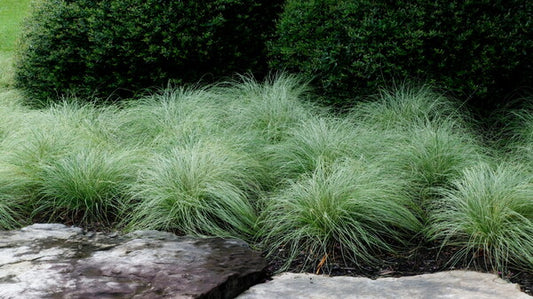 Sold out
Sold outCarex lanceolata 'Silk Tassel'
Item #: 1197
Zones: 5a to 9b
Dormancy: Evergreen
Height: 10" tall
Culture: Part Sun to Shade
Origin: Japan
Pot Size: 3.5" pot (24 fl. oz/0.7 L)
Regular price $22.00Regular priceUnit price per -
Carex laxiculmis 'Hobb'
Item #: 8383
Zones: 4b to 8b, at least
Dormancy: Evergreen
Height: 12" tall
Culture: Part Sun to Light Shade
Origin: Canada, United States
Pot Size: 3.5" pot (24 fl. oz/0.7 L)
Regular price $21.00Regular priceUnit price per -
Carex oshimensis 'Everillo' PP 21,002
Item #: 9802
Zones: 5a to 9b
Dormancy: Evergreen
Height: 12" tall
Culture: Part Sun to Light Shade
Origin: Japan
Pot Size: 3.5" pot (24 fl. oz/0.7 L)
Regular price $22.00Regular priceUnit price per -
Carex pensylvanica 'Straw Hat' PP 29,432
Item #: 14345
Zones: 4a to 7b, at least
Dormancy: Winter
Height: 8" tall
Culture: Part Sun to Light Shade
Origin: Canada, United States
Pot Size: 3.5" pot (24 fl. oz/0.7 L)
Regular price $22.00Regular priceUnit price per -
Carex picta 'Bama Beauty'
Item #: 12814
Zones: 5a to 7b, at least
Dormancy: Evergreen
Height: 8" tall
Culture: Part Sun to Light Shade
Origin: United States
Pot Size: 3.5" pot (24 fl. oz/0.7 L)
Regular price $22.00Regular priceUnit price per
More Information About Carex
Carex (sedge) is the Rodney Dangerfield of the ornamental grass world… “it don't get no respect". From a garden design standpoint, sedges are lumped together with other ornamental grasses, but Carex is not a grass, but a grass-like plant in the family Cyperaceae. We like sedges for their fine textured leaves, their leaf color / variegation, and for how carex improves the health of the local environment by providing food and shelter for insects and birds.
Sedges are a mostly evergreen, ornamental grass that adds a soft texture and form to the landscape. There are 2000 species of carex native around the world so you can have your choice between those which are US natives, and those which are selected for variegated foliage, which primarily hail from Japan. There is sure to be one for most garden situations, particularly shade/moist (many), shade/dry (some) and sun/moist (a few).
Types of Sedge
The two most popular species of sedge used in gardens are Carex oshimensis and Carex morrowii. Both have been grown widely worldwide and are represented in the trade by several variegated foliage selections. Carex oshimensis is a superb evergreen clumping woodland sedge with narrow leaves and an attractive weeping habit. Carex morrowii is a bit more upright in growth habit, and comes in both clumping and running forms, as well as in an array of variegation colors. Carex morrowii var. temnolepis ‘Silk Tassel’ is truly the star of the genus but is rarely available. This has the narrowest variegated foliage of any sedge and thrives in both sun and shade. The US native Carex eburnea is one many of our favorite native sedges. The needle-like texture, small stature, and ability to tolerate dry shade make it a superb choice for the woodland garden.
Using Sedge in the Landscape
Sedges are well-suited to line pathways or fill open spaces in a woodland garden. In form, carex is a perfect substitute for liriope and ophiopogon in shadier spots...but it needs a bit more consistent water than they do. Some sedges are clumpers and others spread by rhizomes. Carex foliage color varies from green, to blue, to gold/orange or variegated. Carex plants generally form arching mounds from 10 inches to more than 3 feet tall. Sedges perform great as container plants too but are less tolerant of moisture swings than other grasses...being too wet or too dry adversely affects Carex health. A few species of sedge (i.e., Carex texensis, Carex leavenworthii, Carex pennsylvanica and others) also make a decent lawn substitute.
Sedge Grass, Carex Flowering
Most carex flower in late winter or early spring, with very few species flowering in fall. The flower spikes are mostly tan, but a few like Carex oshimensis is quite attractive.
Where to Plant Carex
Great companion plants for hosta, most carex perform best when grown in a moist location, although a few are drought tolerant. Sedges are somewhat tolerant of neglect and are resistant to deer... plus they attract butterflies. Carex improves the health of the ecosystem by producing pollen and tiny seeds that are food sources for birds and insects. And the tufted leaves are used as shelter by wildlife too.
Carex Growing Tips
Carex health is easy to maintain with just a few growing tips. Keep them consistently moist but in the summer when their growth slows, be sure not to over water. Waterlogged soils are bad for Carex health and can cause root rot. Soils that are too dry for too long cause Carex health to decline and the plants looking bedraggled. If that happens, cut the sedge plant back, resume watering and the health and appearance will improve.
Propagation
Most carex are easily divided, but that is almost always best from fall until late winter/early spring. Dividing most carex in late spring and summer is a recipe for death of the entire plant.
Additional Resources
Here at Juniper Level Botanic Garden, we have a huge collection of carex in the garden, which are on both trial and display. Many of these are from our wild collections, primarily in the Eastern United States. If you want to buy ornamental grass for a shady site, then consider a sedge.
Need ideas for how to use sedge grass in the garden? Check out Tony's sedge blog posts over at the JLBG.org blog. Or watch our Gardening Unplugged episode on ornamental grasses below for even more ideas on how to use these wonderful perennials in the garden.



